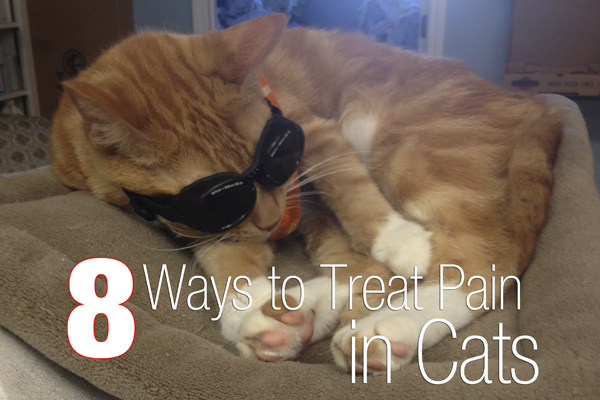8 Ways to Treat Pain in Cats
Guest Blog by Jeff Smith, DVM, CCRP, Middletown Animal Hospital, Middletown, CA

The new AAHA/AAFP Pain Management Guideline state that pain management should include pharmaceutical as well as non-pharmaceutical modalities. MultiModal Pain Management is the new Standard of Care for painful patients
First, check laboratory values (CBC/Chem/UA), BP, and imaging. This is not an exhaustive review of the subject, just a quick summary to act as a checklist of items to study and consider.
DJD is rarely evident on radiographs of cats. Look for muscle atrophy, lack of jumping and lack of activity as the main indicators of joint pain.
1. NSAIDs (COX Inhibitor): Meloxicam is our drug of choice for safety, ease of use, and the ability to titrate or adjust the dose (0.02-0.03 mk/kg SID). This is an off-label use in the US, but an approved use in Europe and Australia.
2. Laser Therapy (decrease pain, decrease inflammation): With contact head administration—3X per week for 4 weeks then 1X week for 1 month then once every 2-4 weeks. Treat at 10-15 J/cm2 depending on severity.
3. Weight Loss—Hill’s Metabolic Diet: Weight loss is equally effective as NSAIDs for pain relief in arthritic patients. This is often an overlooked but important consideration for geriatric cats.
4. Adequan: Twice weekly for 6-8 doses (0.5 to 2.5 mg/lb IM or SQ). Then every 4 months administer twice weekly for 4 doses—this protocol stimulates up regulation of the chondrocytes that will not occur with once monthly injections. This is a much preferred and more effective joint therapy than oral supplements. This the only disease modifying drug we have to use.
5. Gabapentin (Ca Channel): Amantadine (NMDA), Amitriptyline (NE/Serotonin RUI), Bupirnex (Opiod). All 4 agents block the pain pathway at different and unique locations, so they can be used in combination for added effect as needed. Look into the dosages and combined use of these meds as a more advanced extension of this discussion.
6. Omega 3 Fatty Acids/Fish Oil (reduce Arachidonic Acid): High EPA content and high quality. WelActin is our neutriceutical of choice in this category. We give a double dose (640 mg EPA/day/10# Cat) for the first 30 days and then reduce to a maintenance dose (320 mg EPA/day/10# Cat).
7. Environmental Modification: Ramps, steps, lower litter box barriers, rug runners—all help painful kitties get where they want to go with less discomfort.
8. Physical Rehabilitation: Yes! Cats are candidates for rehab, too. Underwater Treadmill, Massage, Passive Range of Motion, Strengthening Exercises, Core Exercises. This is a rewarding and exciting aspect of veterinary medicine to develop. Clients LOVE bringing their pets to rehab!
Consider advanced training such as the CCRP certification offered by the University of Tennessee or consult Darryl Millis’ Canine Rehabilitation Textbook.




Our cat just got knee surgery and has to be rested for almost 2 months and then slowly introduce him back in to physical activity. The vet recommended a few different options, one being rehabilitation, which seems like it can definitely help. I like that you gave the tips of the water treadmill, as it can strengthen their body while putting less pressure on the joints at the same time. It’s something that we will be looking in to as the time gets closer so that we can get him back to health.